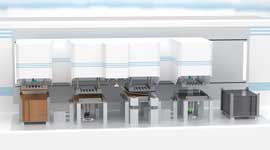New type of silicone actuator for ergonomic controls
- Details
- Hits: 7258
The operation of vehicles and the control of automated processes is becoming more and more complex and diverse. Products for this must perform several functions at the same time, optimally adapt to the installation space and enable downsizing. With the new Silicone actuator technology will the Satiety Group exactly meets these requirements.

Content of the cover story
- The silicone actuator as an artificial muscle
- Application examples for the silicone actuator
- First generation for prototypes
- Second generation with electrical supply
Sateco would now like to bring the new actuator or actuator from the laboratory to the market and industrialize it for it. The silicone actuator SXTA can, based on its operating principle and manufacturing process, increase the functional density required on the market and offers novel approaches to cost-effective solutions.
The silicone actuator as an artificial muscle
 The SXTA is a dielectric elastomer actuator or artificial muscle. It works according to that electrostatic operating principle. Depending on external signals, the actuator can contract and expand again. For example, feedback can be generated using tactile sensors, optical lenses can be positioned or pneumatic systems can be controlled.
The SXTA is a dielectric elastomer actuator or artificial muscle. It works according to that electrostatic operating principle. Depending on external signals, the actuator can contract and expand again. For example, feedback can be generated using tactile sensors, optical lenses can be positioned or pneumatic systems can be controlled.
The actuator is light and able to store energy efficiently and elastically. Applications for the Interior in automobiles, mixed reality, gaming, the Medical Technology and the industrial Automation are his profession.
Technical features and functionality
Silicone actuators measure 10 to 20 mm and can be deformed up to a few millimeters. They generate forces of up to 10 N. The SXTA consists of several hundred layers of microscopically thinner elastic Silicone layers and electrically conductive carbon electrodes.
When an electrical voltage is applied between the electrodes, the actuators are electrically charged. An electrostatic field is built up in them. The field creates a electrostatic forcewhich can pull the actuators together between the electrodes on the basis of the flexible elastic silicone. The muscle is tensed. It dissolves again when the electrical charge z. B. is discharged by a short circuit. The reduction in charge weakens the electrostatic attraction. The elastic silicone layer mechanically brings the actuators back to their original shape.
 Air circuit breaker, digital protection relay and soft starter
Air circuit breaker, digital protection relay and soft starter
Silicone actuators act like an electrostatically controllable one Spring elementwhich moves, stiffens and stores energy. The deformation and the force are proportional to the applied voltage. Thanks to the energy storage, the actuator holds a certain position with very little energy.
Comparison with piezoelectric element and lifting magnet
 The silicone actuator has compared to a piezoelectric stack actuator much more power. With a relatively large stroke, silicone actuators generate high forces. They create a multiple stroke of piezoelectric stack actuators with the same length.
The silicone actuator has compared to a piezoelectric stack actuator much more power. With a relatively large stroke, silicone actuators generate high forces. They create a multiple stroke of piezoelectric stack actuators with the same length.
In contrast to Lifting magnets the SXTA can approach a certain deflection proportional to the input signal and hold it almost without energy. Because he doesn't Metals it is very light. The actuator essentially consists of silicone. This makes it robust. To shear forces and impacts, it is much less sensitive than z. B. a piezoelectric actuator.
Be Manufacturing process enables a variable shape, because its design is not imposed by geometries such as joints and coils. This allows the actuator to be miniaturized efficiently.
Design options and user benefits
Thanks to the relative freely selectable form The silicone actuator gives developers new design options, for example for ergonomic control units. The actuator can be adapted to the available space. It hugs even slightly curved surfaces.
Because it can hold a deflection almost without energy thanks to its electrostatic operating principle, the silicone actuator is very energy-efficient. The one with it is possibly longer lasting battery operation is an important benefit for portable devices.
 Reinvention of the display for the car cockpit of the future
Reinvention of the display for the car cockpit of the future
With the relatively large one Hub With the silicone actuator, the user can simplify its structure. Positioning can be done without Transmission or redirect. With the elastic material of the actuator, functions such as damping vibrations, unraveling through mechanical preload and installation tolerances can be compensated. This leads to savings in components and costs.
Because the silicone actuator made of silicone can be moved statically and dynamically, it is able to execute fast pulses as well as slow deformations. He can any deflection start and stop continuously. The SXTA thus performs several functions at the same time and makes the system less complex.
The monolithic design makes the actuator robust, shock and impact resistant. It withstands temperatures from -40 ° to + 85 ° C and has a long service life.
Application examples for the silicone actuator
Below you will find some application examples for automobile interiors as well as initial approaches for medical technology.
Automobile: door control unit with integrated haptics
In the area Operating haptics Sateco works with the automotive supplier on decorative surfaces Marquardt together. The developed prototype of a door control unit, which has an integrated haptic, received the feedback in the form of a mechanical pulse. In contrast to the currently implemented surfaces with integrated haptic feedback, the demonstrator has no gap between the haptically active surface and the inactive attachment of the surface. This simplifies the structure considerably.
A certain formation of the surface was concentrated haptic signals on a selected area of the control surface. The haptic feedback can only be felt as a click when the finger touches the surface in the selected area. A major functional advantage of the silicone actuator compared to piezoelectric actuators is the relatively low-noise generation of the haptic feedback. This property contributes a lot to the value of a vehicle.
The above demonstrator essentially uses the fast movement of the actuator. The developers of the automotive interior endeavor to add a Texture or topography to give. This makes operation easier because it gives the finger orientation aid. In addition, only the information that is in the context of a specific operation can be highlighted on a surface. This reduces the distraction of the user.
Two Demonstrators present how hard control buttons can very easily appear from a smooth surface using silicone actuators and how textures can be created in flexible soft textile surfaces. These demonstrators use the full potential of the actuator. With its large stroke, it lifts and lowers the buttons or the textile directly from the surface.
 Radar sensor in car headlights creates space in the vehicle
Radar sensor in car headlights creates space in the vehicle
Keys or moving parts of the surface are connected to the actuator and are pushed and pulled out of the surface by its contraction. This movement seems silent and very spontaneous. Keys or texture can be held as long as you like.
In addition, the silicone actuator can generate haptic feedback through a superimposed rapid movement as soon as the highlighted texture or key is touched. In the Marquardt example, there is a Pulse felt as a key click so
Medical technology: energy-efficient handling of liquids
In medical technology, the actuator can be used as a Pump or valve energy-efficient liquids are handled. Because the silicone actuator can hold a deflection with almost no energy requirement, it is very suitable for dosing and dispensing liquids.
In addition, the direct proportional control of the actuator deflection allows pulsation-free conveyance. In comparison, lifting magnets generate a pulsation with each delivery stroke due to the mechanical impact of the magnet against the stop. In contrast, silicone actuators can be controlled in such a way that the transition from one stroke to the other is continuous and pulsation-free.
The actuator material is also advantageous in medical technology. Since it essentially consists of silicone, it can be integrated directly into common, medical-technical articles based on silicone, such as in Hoses. The direct integration of the actuator reduces interfaces that can contaminate the media to be conveyed. And the silicone actuator can be exchanged efficiently together with the hose.
First generation for prototypes

The first generation of the SXTA1 silicone actuators is currently available for trials and prototypes. You will be working with a start-up of the EMPA (Eidgenössische Materialprüfungsanstalt, part of ETH Zurich) produced in Switzerland on a system for prototypes. There are three types of patterns.
 Facts and components from and for battery production
Facts and components from and for battery production
The smallest actuator, the SXTA1-1005, has a base area of 5 x 5 mm and is 5 mm high. This enables a stroke of approx. 0,2 mm with a force of approx. 1 N to be generated. Its bigger brother, the SXTA1-1010, is twice as high and can achieve approx. 0,4 mm stroke at 3 N. The largest variant SXTA1-1520 has a base area of 15 x 15 mm and a height of 20 mm. This actuator can contract by approx. 0,7 mm and generate a force of up to 10 N. The height, the achievable stroke and the force can be adjusted within a certain range on customer request. On Starter Kit includes silicone actuator, software, drivers and electronic steering.
Second generation with electrical supply
Together with the start-up, the Sateco Group is already working on SXTA2, the second generation of silicone actuators. Compared to the first generation, the second has one connected to the electricity grid. This is comparable to piezoelectric stack actuators (600 V). This reduces the effort for electronic integration of the component. Improved electrically conductive materials are also used. These extend the life of the actuators. The test data are currently being prepared. The first samples should be available from mid-2021.
Pioneering achievement in industrialization
In contrast to the first generation, the SXTA2 can be manufactured in quantities of several 100.000 parts per year. The Sateco Group is building a new type of machine at its Schwerzenbach location to implement this number Production facility with a 200 m² clean room. The production system must have a very high level of precision and an extremely high level of repeatability should be guaranteed. When manufacturing a silicone actuator, several hundred layers of microscopically thin, elastic silicone layers have to be stacked on top of one another without defects and within tight tolerances.
Sateco is exhibiting at the Sensor + Test 2021.

Daniel Haefliger is CEO of Sateco XT AG in Schwerzenbach, Switzerland.
